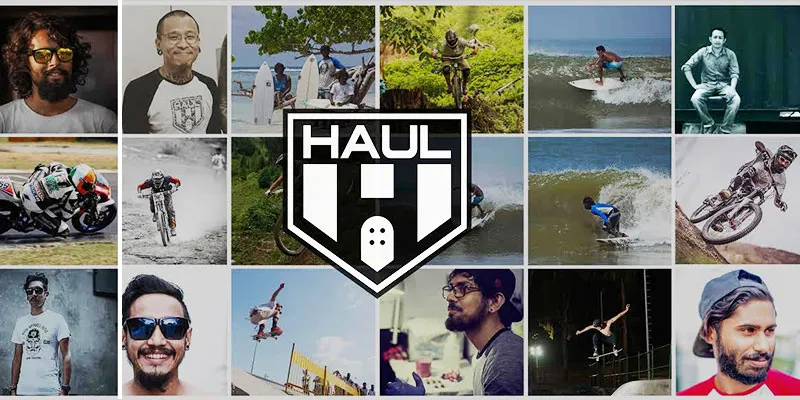Haul Apparel, a lifestyle brand introducing a mix of subcultures to Indian youth
In comparison to our country’s history with trends and fashion, it seems that millennials and the younger generation of today have begun to pay more attention to how they look and dress. It’s a statement for them - a way to express themselves without speaking audibly. Though there are plenty of clothing brands and retailers in India, even foreign ones, they are either overpriced or irrelevant to current fashion trends abroad.
Twenty-four-year-old Sohan Rodrigues and 27-year-old Sushobhit Chaudhury first met at Play Arena Skate Park in Bengaluru, where they bonded over their shared interest in subcultures and apparel. They came together to fill a gap in India’s apparel industry, which they deemed to be a combination of non-conventional designs, coupled with high-quality, locally-sourced materials. Accordingly, they built their brand image with the foundation of merging Indian culture with Western style, to offer their customers the best of both worlds.
Sushobhit says, "While we founded Haul Apparel in March 2015, planning and design had begun in 2014 itself, spearheaded by Nepali artist and graphic illustrator Kayo Siddhi. We eventually launched our original collection in November 2015."
Having lived in places like Dubai, Hong Kong, and the UK, they had naturally become influenced by the cultures and subcultures that these places had to offer, most particularly with regard to skateboarding and other recreational sports. This led them to wear clothing by brands that championed these activities; this included the likes of HUF and Vans, which are both US-based.
Sushobhit grew up in Hong Kong and was an integral part of a number of startups before taking some time off and moving to Bengaluru. Sohan grew up in Dubai, completed his undergraduate Mechanical Engineering degree in the UK, and then moved to Bengaluru, where his extended family lives.

Core product
Haul Apparel is dedicated to the principles of enabling every person to participate in riding and boarding throughout their lifetime, whether it’s for fun, fitness, or any other achievement. Its aim is to encourage and support the steady increase of extreme sports awareness throughout India and Nepal. Their products include snapback hats, t-shirts, shirts, and hoodies.
Sohan says, "In essence, our brand’s ethos is to provide clothing apparel and exposure for the creative youth of India; these are those who are immersed in the subcultures of skateboarding, surfing, mountain biking, street art, tattooing, and so on. We want to offer them an equally creative outlet to purchase apparel and meet like-minded individuals, and to support and nurture these activities that influence us so that we can all grow together."
Market estimates
The Indian apparel retail sector accounts for 8 percent of overall apparel sector in the world, which is equivalent to $50 billion. The size of India’s textile market in 2014 was $99 billion and is expected to touch the $226 billion mark by 2023, growing at a CAGR of 8.7 percent between 2009-23.
Apparel had a share of 40 percent of the sector’s export market in 2014, with textiles claiming the other 60 percent. Exports have been a core feature of India's textile sector. Exports grew to $41.4 billion in FY15 from $17.6 billion in FY06. The global streetwear market, meanwhile, amounts to over $175 billion.
Sushobhit adds, "People love India; they love the art, culture, people, food, and much more that India has to offer. We have a loyal fanbase even outside of India, and with time, we really see ourselves competing globally."
Haul Apparel's customer base has reached over 1,200 people, out of which 90 percent have been gained in the last seven months. Approximately 60 percent of the company’s customers come from India, with the remaining 40 percent in Nepal.
Founders bootstrapped around 35 lakh and have seen an investment of around 1.05 crore.
Competitors
When asked about their competitors, Sushobhit points to Vans and Quicksilver, which have entered India through VF Corporation and Reliance Distribution respectively.
Among the India-born competitors are Wrogn and Breakbounce. Wrogn, started in 2014, is a breakaway men’s youth fashion brand with the face of cricketing icon Virat Kohli. Their products are of good quality, and their ambassador plays a key role in establishing brand recognition and awareness.
Breakbounce, meanwhile, has a similar style and design to Wrogn. Breakbounce plays on the use of colors to attract their customers. Established and well funded, their presence has remained at a consistent level since their entry in 2012.
Challenges faced while taking the company to the next level
As a small brand with limited funding, Haul has a vision of providing products of the highest quality to their customers, even though, currently, its production quantity is quite low. This poses a challenge, as a combination of high quality and low production means higher production cost per piece. The company has increased its production quantities with each launch, cutting its costs to a certain extent. It sees this as a short-term challenge, which will soon be rectified as the demand for its products increases.
Being a new company with a bold brand image, one of its main challenges is to break through the country’s norm, which is more conservative in nature. More often than not, the average person would naturally resent or reject what they do not understand. This proved to be the case when the brand was launched, as many people outside of its subculture circles were not ready to embrace what it had to offer. However, over time, the company has seen a significant improvement, due to both word of mouth and its guerrilla marketing techniques. It has helped them increase awareness of their brand, and cemented loyalty amongst its customers.







